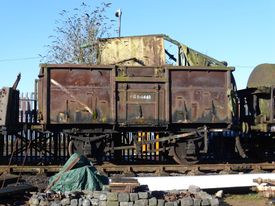BR 118443 Mineral Wagon
| BR 118443 Mineral Wagon | |
|---|---|
 BR Mineral Wagon 118443 | |
| Built By | GRCW |
| Status | Stored |
| Number | ADE 118443 |
| Other Numbers | B 118443, I/U 041451 |
| History | |
| Built | 1951-2 |
| Diagram | 1/108 |
| Lot | 2380 |
| Type | 4-wheel steel mineral wagon |
| Capacity | 16 tons |
| TOPS code | MCO |
| Brakes | Unfitted |
This example, originally numbered B 118443, was built by the Gloucester Railway Carriage and Wagon Company in 1952 as Lot 2380.[1] It was condemned as an MCO in 1978 and subsequently transferred to Internal User stock as number 041451 in 1980. In that role it was allocated to Immingham TMD where it was fitted with a tank and vacuum system and used to clear oil and sludge from the drains.[2]
The date of its arrival on the SVR was not published; it was not recorded in the Stock Book of June 1998 but was photographed at Kidderminster Railway Museum in May 2006.[2] As of 2020[update] it is still stored there awaiting restoration. The tank is still in situ and can be seen in the wagon in the main photograph.
See also
References
- ↑ 1.0 1.1 Rowland (1996) pp. 9, 41, App 4.
- ↑ 2.0 2.1 Departmentals.com
